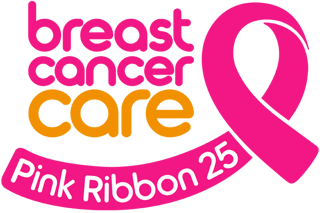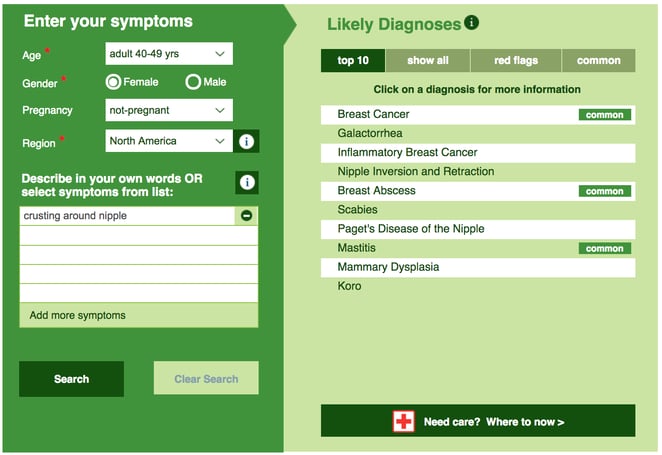- Privacy Policy
- Terms & Conditions
- Contact us
- ©Isabel Healthcare 2025
Could I have Breast Cancer? | Awareness Month | Symptoms
 Noticed a lot of pink around recently? That’s because October is Breast Cancer Awareness Month. Around the world, people are wearing pink or sporting the familiar pink ribbon in support of this annual worldwide campaign involving thousands of organisations which are aiming to increase awareness, education and research into Breast Cancer. The pink ribbon has been an international symbol for breast cancer awareness for 25 years, and to mark this special anniversary charities around the world are doing even more to get people talking about, and importantly, spotting early signs of, breast cancer.
Noticed a lot of pink around recently? That’s because October is Breast Cancer Awareness Month. Around the world, people are wearing pink or sporting the familiar pink ribbon in support of this annual worldwide campaign involving thousands of organisations which are aiming to increase awareness, education and research into Breast Cancer. The pink ribbon has been an international symbol for breast cancer awareness for 25 years, and to mark this special anniversary charities around the world are doing even more to get people talking about, and importantly, spotting early signs of, breast cancer.
The good news is that more women are surviving the disease than ever before; between 1989 and 2015 the death rates dropped by a massive 39% thanks in large part to the awareness campaigns which have led to earlier diagnosis and consequently earlier and more effective treatment. Nevertheless, over 252,000 women in the US will be newly diagnosed each year with the disease of which sadly approximately 40,000 will die. Breast Cancer is still the second most common cause of death in women but increased awareness is essential if the various breast cancer charities around the world are to achieve their ultimate goal of zero mortality from the disease.
What is Breast Cancer?
Normally the cells in our body replace themselves through an orderly process of cell growth. Breast cancer occurs when particular cells in the breast begin to grow out of control. These cells usually form a tumour which can often, but not always, be felt as a lump. This is known as Primary Breast Cancer. If left untreated, these cells grow into the surrounding tissue or spread (metastasize) to other parts of the body, which is then known as Secondary Breast Cancer.
Breast Cancer Symptoms
Breasts change both with age and at different stages of your life, such as during pregnancy or menstruation, so it’s important to get to know how they normally look and feel so you can easily spot any changes. The most noticeable symptom is usually a lump. Be aware that most breast lumps (up to 90%) are non-cancerous, but always get them checked out with your doctor as soon as you can. What’s more, sometimes a lump is less evident or cannot be felt, and so there are other symptoms to look out for when examining your breasts. If you notice any of the following symptoms you should visit your doctor:
- A change in shape or size of one or both breasts
- Discharge from either of your nipples
- Lumps or swelling in your armpits
- Any dimpling of skin on your breasts
- A change in appearance of your nipple, eg one might become inverted
- A rash or crusting around your nipple
Most cases of breast cancer are found by women noticing unusual changes or lumps. Finding these at an early stage massively increases your chances of successful treatment, so it is essential that all women regularly self-examine. A great charity in the UK called CoppaFeel has lots of information on when, how and why to check your breasts, including a video below explaining what you’re looking for.
Causes of Breast Cancer
Our genes, lifestyle and environment can all affect our risk of developing breast cancer. The following factors can increase the risks:
- If you have 2 or more close relatives (ie your mother, sister or daughter) who’ve had either ovarian or breast cancer
- Drinking 2 or more alcoholic drinks a day
- Being overweight, especially if you’ve been through the menopause
- HRT (Hormone Replacement Therapy). This is associated with increasing your risk, especially with long term users. However this risk reduces once you stop taking it
- Taking a contraceptive pill, although this increase in risk is extremely low and, again, reduces when you stop taking the pill
- Certain medical procedures involving radiation, notably if you had radiotherapy for Hodgkin Lymphoma; these risks should have been discussed with you before embarking on your radiation treatment
- Over-exposure to Oestrogen, for example if you started your periods early and you had a late menopause
- A previous diagnosis of breast cancer
Men Can Get Breast Cancer Too!
In rare cases men can also get breast cancer, which is why men shouldn’t ignore suspicious lumps and bumps and any of the symptoms mentioned above. Men who are particularly susceptible include:
- Those with a family history of the disease
- Men who are taking medication known to increase oestrogen in the body, such as drugs medicines used for prostrate cancer
- Men who have had radiotherapy in the chest area.
How is Breast Cancer diagnosed?
If you notice any of the symptoms above, visit your doctor as soon as you can for an examination. This will dictate whether or not you are then referred on to a specialist breast clinic where any of the following could take place:
- A Mammogram and/or breast ultrasound depending on your age. This is usually carried out by specialist female nurses who will x-ray one breast at a time. In many countries, mammograms are recommended for anyone over 50 even if they are symptom-free, as mammograms have been instrumental in bringing rates of breast cancer down
- A Biopsy. When an imaging test shows a breast change that may be cancerous, a biopsy is the only way to verify this for sure. This is where a sample of tissue cells is taken from your breast by needle for analysis
If you’re not sure whether the symptoms you’re experiencing may be related to breast cancer or anything else, type them into the Isabel Symptom Checker to check the possibilities.

Treatment Options for Breast Cancer
Treatment for Breast Cancer has changed dramatically in recent years and patients now have a much wider and less invasive range of treatments available. Your doctor will help you decide which is the best treatment for you.
The most common treatments are:
- Surgery
- Radiotherapy
- Chemotherapy
Depending on the type of cancer and whether it’s spread or not, you may have just one of these treatments or a combination. Breast cancer diagnosed at a regular screening may be at an early stage so will require different treatment from a cancer detected as a result of symptoms that have already developed. Surgery is usually the first line of attack against all breast cancer and will be determined by your doctor, depending on the stage of your cancer. You are most likely to receive either a Lumpectomy (removal of just the tumour and a small amount of surrounding tissue) or a Mastectomy (removal of all the breast tissue). If the biopsy reveals that the cancer has spread to the lymph nodes, these can also be removed. After this, you may or may not be put through a course of radiotherapy or chemotherapy, or both. If your cancer has spread (metastasized) and you have been diagnosed with secondary breast cancer, then treatment will aim to control your cancer, but it sadly cannot cure it, and the treatment options are much more complex. Make sure you discuss all the options with your doctor before coming to a decision with them.
The improved survival rates of Breast Cancer, particularly in the developed world, have been one of the great success stories of modern medicine. By supporting Breast Cancer Month and helping to continue that awareness, we stand a greater chance of reducing those numbers even more. If you would like a charity pack, more information, or a pink ribbon, we have several links below to the national charities in the UK and the US.
If you have any concerns over your symptoms, place them into the Isabel Symptom Checker and discuss the results with your doctor. You can try out the Isabel Symptom Checker below:
Charity links
https://www.breastcancercare.org.uk/
http://www.pinkribbonfoundation.org.uk/
http://www.nationalbreastcancer.org/
Subscribe Here!
Recent Posts
Isabel DDx Companion with ChatGPT Integration - to help you diagnose even faster
At Isabel Healthcare, we’ve always been driven by one goal: to make clinical reasoning faster,..Virtual Triage: Do more questions lead to better patient outcomes?
One of the common misconceptions related to virtual triage / symptom checker tools is that the more..List Of Categories
- Differential Diagnosis Decision Support
- Differential diagnosis
- Symptom Checker
- Symptoms
- Medical Error
- Patient Disease Information
- Disease
- Clinical Decision Support
- Diagnostic Decision Support
- Isabel 1 Minute Read
- Diagnosis Error
- Diagnosis Skills Cases
- Healthcare Informatics
- Clinical Reasoning
- Evidence-based Medicine
- Medical Education
- Patient Engagement
- Symptom Triage
- Nurse Practitioner Education
- Nursing Decision Support
- Partnership
- Public Health
- COVID-19
- EHR
- Patient Empowerment
- Patient Safety
- rare disease

Start your FREE Trial today
Try the Isabel Pro DDx generator for 30-days - no payment card details required.




